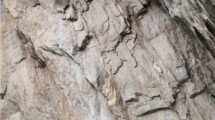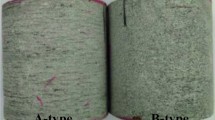Abstract
Triaxial compression creep tests were conducted on Wudang mica schist samples to clarify the creep anisotropy characteristics. The mica schist samples were divided into parallel group and vertical group according to the angle of axial loading and schistosity plane. The creep tests were set up with step function loading under varied confining pressure conditions. The test results show that mica schist creep have 4 stages: instantaneous deformation stage, decay creep stage, steady creep stage and accelerating creep stage. The deformation is dominated by instantaneous deformation at low levels of stress. Then the creep value continued to increase as the stress grew. In comparison with the vertical group under same confining pressure and similar axial loads, the parallel group presented large instantaneous strain increments and axial creep value, high creep speed and short decay creep time. Experimental results showed that the vertical group was finally destructed in the form of shear fracture and the parallel group was finally destructed in the form of cleavage fracture, which indicated distinct creep anisotropy. A modified burgers creep model was introduced to describe mica schist’s creep characteristics and identify the creep parameters, and the result was proved to be efficient in description of mica schist’s creep features by the fitting results.









Similar content being viewed by others
References
Dubey RK, Gairola VK (2008) Influence of structural anisotropy on creep of rocksalt from Simla Himalaya, India: an experimental approach. J Struct Geol 30(6):710
Fujii Y, Kiyama T (1999) Circumferential strain behavior during creep tests of brittle rocks. Int J Rock Mech Min Sci 36(3):323–337
Han G, Wang S, Zhang X et al (2010) Study of creep properties of thinly laminated rock under step loading. Chin J Rock Mechan Eng 29(11):2239–2247
Ito H, Sasajima S (1987) A ten-year creep experiment on small rock specimens. Int J Rock Mech Min Sci 24(2):113–121
Jiang Y, Xian X, Xiong D (2005) Study on creep behaviour of sandstone and its mechanical models. Chin J Geotech Eng 27(12):1478–1481
Li Y, Xia C (2000) Time-dependent tests on intact rocks in uniaxial compression. Int J Rock Mech Min Sci 37(3):467–475
Li Y, Zhu W, Bai S et al (2003) Uniaxial experimental study on rheological properties of granite in air-dried and saturated states. Chin J Rock Mech Eng 22(10):1673–1677
Li H, Li Z, Su C (2004) Testing study on creep characteristics of marble. Chin J Rock Mech Eng 23(22):3745–3749
Shen Z, Xu Z (1997) Creep test of granite for the Three Gorges dam foundation. J Hohai Univ 25(2):1–7
Sun J (2007) Rock rheological mechanics and its advance in engineering applications. Chin J Rock Mech Eng 26(6):1081–1106
Tao Z, Wang H, Yu Q (1991) Experimental study on rheological properties of marble under step loading. Sichuan Water Power 1:23–29
Ulusay R, Hudson JA (2007) The complete ISRM suggested methods for rock characterization, testing and monitoring: 1974–2006. Kozan Ofset, Iskitler Ankara
Wu C, Shi Z, Fu Y et al (2014) Experimental investigations on structural anisotropy on creep of green schist. Chin J Rock Mech Eng 33(3):493–499
Yang C, Daemen JJK, Yin J (1999) Experimental investigation of creep behavior of salt rock. Int J Rock Mech Min Sci 36(2):233–242
Yuan H, Cao P, Xu W et al (2006) Visco-elastop-lastic constitutive relationship of rock and modified Burgers creep model. Chin J Geotech Eng 28(6):796–799
Zhang Y, Xu W, Gu J et al (2013) Triaxial creep tests of weak sandstone from the deflection zone of high dam foundation. J Centr South Univ Technol 20(9):2528–2536
Zhang Y, Xu W, Shao J et al (2015) Experimental investigation of creep behavior of clastic rock in Xiangjiaba Hydropower Project. Water Sci Eng 8(1):55–62
Zhang Y, Jin P, Xu W, Zhao H, Mei S (2016) Experimental study of triaxial creep behavior and long-term strength of clastic rock in dam foundation. Rock Soil Mech 37(50):1291–1300
Author information
Authors and Affiliations
Corresponding author
Additional information
Publisher's Note
Springer Nature remains neutral with regard to jurisdictional claims in published maps and institutional affiliations.
Rights and permissions
About this article
Cite this article
Xu, J., Chen, J., Jiang, P. et al. Investigation of Creep Behaviors of Wudang Mica Schist by Triaxial Compression Tests. Geotech Geol Eng 37, 3831–3842 (2019). https://doi.org/10.1007/s10706-019-00872-7
Received:
Accepted:
Published:
Issue Date:
DOI: https://doi.org/10.1007/s10706-019-00872-7




